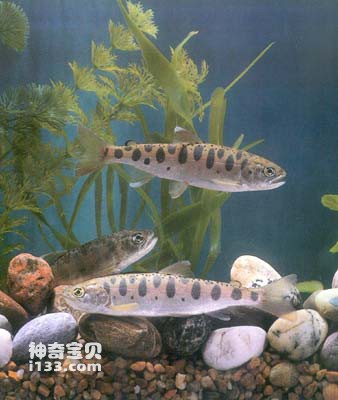Taiwanese masu salmon (Oncorhynchus masou formosanus) belongs to the order Salmoniformes, Salmonidae, and the genus Salmon. Common names: Plow Mountain Trout, Sakura Gelsemium Trout, Subalpine Trout. English name: Cherry salmon, Masu salmon.
Endangerment level: Endangered.
The body is long spindle-shaped and slightly flattened laterally. The snout is prominent, slightly curved, the mouth is terminal, the oral cleft is long, and the oral cleft can reach below the posterior edge of the eye. The maxilla extends backward past the posterior edge of the eye. The upper and lower jaws have teeth. The lateral lines are straight. The adipose fin is closer to the caudal fin than to the dorsal fin. The tip of the adipose fin is free. Caudal fin meniscus. The back of the body is greenish-green, the belly is silvery white, there are 9 oval moiré spots in the center of the body side, and 11-13 small black spots above the lateral line.
The Taiwanese salmon is a remnant species that came from the north during the Ice Age and has become a land-locked fish that has settled in freshwater rivers. It is unique to Taiwan Province of my country and only lives in the Lishan stream at an altitude of more than 1,500 meters in the upper reaches of Dajia River in Taiwan Province of my country. It is one of the two known southernmost species of salmonid species in the world ( The other is in Mexico). This species inhabits clear streams with water temperatures below 15°C. The requirements for water quality and dissolved oxygen are very high. It feeds on aquatic insects or insects fallen into the water, and can generally grow to 200-300 mm.
The amount of salmon in Taiwan has not been investigated in depth in the past. In recent years, due to overfishing, the number has been greatly reduced and it is now on the verge of extinction. Relevant departments in Taiwan Province began conducting artificial breeding experiments in the early 1970s and achieved success. On this basis, Taiwan's local government has strengthened research on the breeding and protection of this species, conducted in-depth investigations into its ecological environment and resource status, and strictly prohibited fishing.

animal tags:
We created this article in conjunction with AI technology, then made sure it was fact-checked and edited by a Animals Top editor.